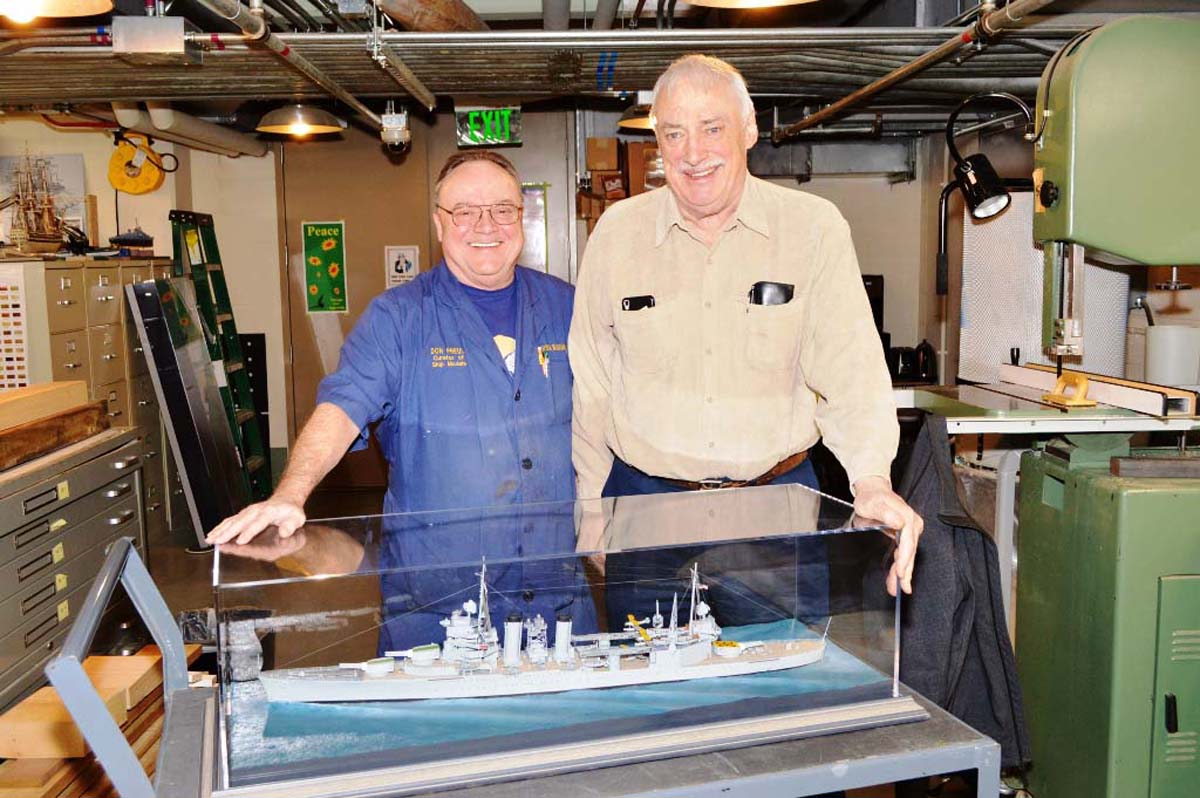
l-r: Don Preul, Curator, US Naval
Academy Museum; Gary Kingzett

l-r: Don Preul, Curator, US Naval
Academy Museum; Gary Kingzett
|
|
|||||||||||||||||||||||||||||||||||||||||||||||||||||||||||||||||||||||||||||
| On a cold and sunny late February
weekend, Gary Kingzett and I drove down to Annapolis, Maryland, where Gary
was to donate his scratch-built 1/192 scale model of the
USS
San Francisco (CA-38) to the Naval Academy Museum.
When the model was originally completed some years ago (circa 2008), Gary
had stated that "I built the model
as a “Thank You” gift for Lou Parker (San Francisco veteran). For him and
his shipmates who fought in World War II, and for the kind of man Lou is
today, knowledgeable and helpful and encouraging to anyone who asks for
anything Navy. I am going to take the model to the State of Washington
and present it to Lou at his home. Ultimately, he plans to donate it to
the Mare Island Navy Yard Museum. Hopefully the people at the museum will
be pleased that one of their most famous alumni (or at least a model of
her and her spirit) have finally come home."
Regrettably, after Lou Parker died, the model was not able to be donated to the Mare Island Museum, so Lou's children shipped it back to Gary. Now we were on our way to deliver her to the US Naval Academy Museum, where she would join another of Gary's scratchbuilt models, the USS New Jersey (BB-16). The benefit of helping Gary deliver his San Francisco model to the Naval Academy Museum was that we were going to get to see the modeler's workshop and get a tour of the museum, from none other than the curator himself, Don Preul. According to their website, The U.S. Naval Academy Museum welcomes more than 100,000 visitors annually from all over the world. Located in Preble Hall on the grounds of the U.S. Naval Academy, the Museum offers two floors of exhibits about the history of seapower, the development of the U.S. Navy, and the role of the U.S. Naval Academy in producing officers capable of leading America's sailors and marines. |
|||||||||||||||||||||||||||||||||||||||||||||||||||||||||||||||||||||||||||||
|
|
|||||||||||||||||||||||||||||||||||||||||||||||||||||||||||||||||||||||||||||
| THE MODEL SHOP | |||||||||||||||||||||||||||||||||||||||||||||||||||||||||||||||||||||||||||||
| Deep in the bowels of the museum is the model and shop and reference library. On Saturday's, volunteers come and work on building new models for displays or refurbishing existing models in the museum's collection. There were certainly some interesting models to be seen. Everything from the original builders model of the Maine, which is going to be refurbished to her "as-designed" configuration, with sails, to a collection of 1/700 waterline ships built by some of the volunteers for fun, to a model of a German WW2 destroyer. Originally built by Hitler Youth and "liberated" by the US Army, it eventually made it's way to the Naval Academy Museum. | |||||||||||||||||||||||||||||||||||||||||||||||||||||||||||||||||||||||||||||
|
|
|||||||||||||||||||||||||||||||||||||||||||||||||||||||||||||||||||||||||||||
| THE MUSEUM | |||||||||||||||||||||||||||||||||||||||||||||||||||||||||||||||||||||||||||||
| The museum is located on two "decks". The first deck is a history of the United States Navy, from Revolutionary War days until the Space Age. There are interesting artifacts - like the actual "Don't Give Up The Ship" flag - uniforms, relics of actual ships and, of course, lots of models, many of which were build in the basement of the building. Don said, where possible, they like to put some related to the real ship next to the model. There is a number of builders models displayed as well, especially in the entrance lobby. Some of my favorites were the models of the destroyers Maury and Selfridge, the cruiser Helena and the carrier Langley. In the Space Age section, Don has managed to get many of the naval pilots who participated in the Apollo program to sign various exhibits, most prominent is a large Saturn rocket. Don brought us into the museum from the basement, so we did our tour in reverse - we started in the entrance lobby, then worked out way to the Space Age and ended up at the Revolutionary War. | |||||||||||||||||||||||||||||||||||||||||||||||||||||||||||||||||||||||||||||
|
|
|||||||||||||||||||||||||||||||||||||||||||||||||||||||||||||||||||||||||||||
| THE "SECOND DECK" - THE CLASS OF 1951 GALLERY OF SHIPS | |||||||||||||||||||||||||||||||||||||||||||||||||||||||||||||||||||||||||||||
On the second "deck" of Preble
Hall is the "Class
of 1951 Gallery of Ships". These model all date from the age
of sail. Some of them are quite old, including one model that dates
from the 1600's. I believe Don said it was one of the oldest known
ship models in the world. The exhibits on this deck include the Rogers
Ship Model Collection and the Bone Model Collection. From the museum
website:
|
|||||||||||||||||||||||||||||||||||||||||||||||||||||||||||||||||||||||||||||
|
|
|||||||||||||||||||||||||||||||||||||||||||||||||||||||||||||||||||||||||||||
| Thanks to Gary Kingzett for dragging me with him, and many thanks to the curator, Don Pruel, for the tour of the model shop and museum, and for the background story on so many of these models. It was an interesting and informative day! | |||||||||||||||||||||||||||||||||||||||||||||||||||||||||||||||||||||||||||||
|
|
|||||||||||||||||||||||||||||||||||||||||||||||||||||||||||||||||||||||||||||
